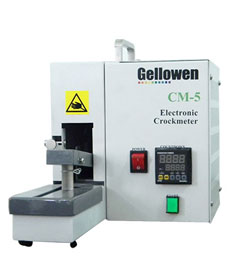
NewsInformation Center
Preparation for the IULTCS Leather Friction Tester test
2022/06/29
The IULTCS Leather Friction Tester is suitable for testing the abrasion resistance of products such as plastics, automotive parts, rubber, leather and textiles, electroplating, freely removable components, lacquers, printed graphics, etc. It can be used both to evaluate the abrasion resistance of products and to evaluate the scratch resistance (single or multiple scratches) and color transmission of products. Both dry and wet abrasion tests can be performed. It can test samples of any size or shape, and is ideal for abrasion testing of products with contoured and polished surface characteristics.
Testing principle.

Friction head (with or without additional weights) on the square wool felt on the friction platform of the leather (stretched or not stretched) for reciprocal friction, a certain number of times after the wool felt for color staining gray card comparison, the test leather for color loss gray card comparison, evaluation of the grade.
Preparation before the test.
Test before the instrument needs to be connected to the power supply, the exhaust port connected to the vacuum cleaner.
Accessories and other instruments: a pair of standard grinding wheels, double-sided adhesive (hard), fine sandpaper (for calibration). According to the requirements of different standards also need to prepare 0.1mg precision balance, fabric strength machine, appearance evaluation light box, etc., to evaluate the test results.
Specimen: cut to about 110mm, leaving a hole of 8mm in the middle. if you need to compare the weight change before and after the specimen, you need to weigh the original weight of the specimen in advance (such as the specimen is a fabric, etc. need double-sided tape fixed, you need to stick to the standard double-sided tape after removing the outer layer of stickers, weighing its weight); if you need to compare the strength change before and after the specimen, you need to test its original strength before the test; compare other properties such as haze are required before the test corresponding Test to determine the original parameters. The specimen should be pre-wetted for at least 8h.
Speed regulation: After power on, start the instrument under the state of double arm lifting, and adjust the speed knob to the required speed according to the digital display.
Operating instructions.
The tester is easy to operate. Place the specimen on the tester surface and fix it with the random clamp. Use the knob or screw to adjust the pre-tension according to the percentage scale engraved on the test bench. The tester is equipped with a counter that automatically stops the tester when the set count is reached. A square felt pad is inserted into the processing collet at the end of the friction head. The friction head is lowered into contact with the specimen and the tester is started. The surface of the material and the pad are visually inspected to observe the degree of discoloration and the wool felt pad is evaluated using the supplied gray scale.
Previous: How to choose the correct fixture for UV Aging Test Chamber?
N e x t : What instruments are generally used for leather wear testing?



